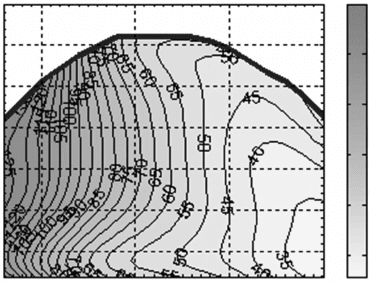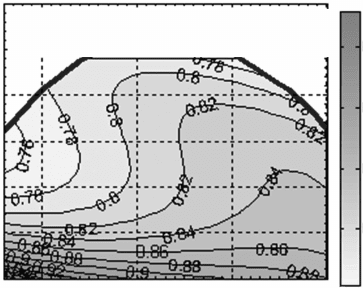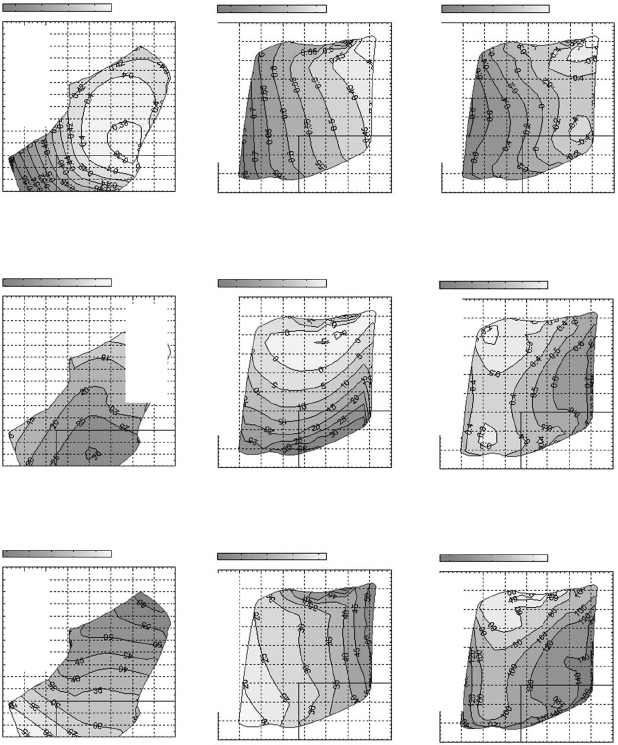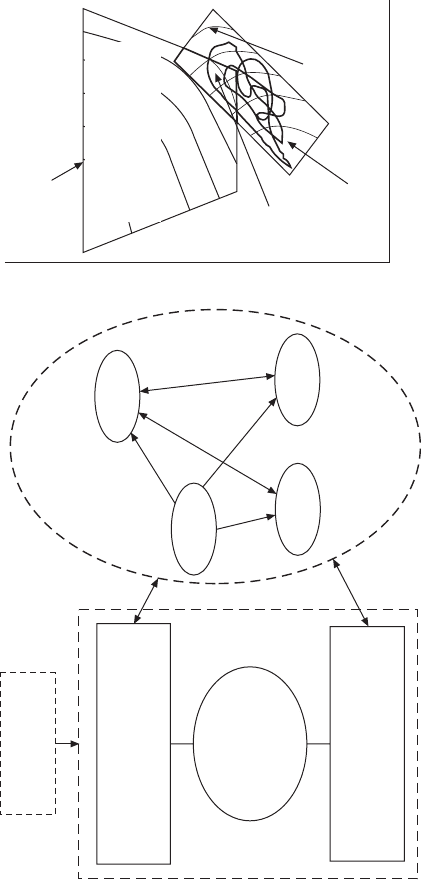Xin Q. Diesel Engine System Design
Подождите немного. Документ загружается.


508 Diesel engine system design
© Woodhead Publishing Limited, 2011
A group of researchers at Michigan Technological University
(Huynh et al., 2003; Kladopoulou et al., 2003; Singh et al., 2005;
Mohammed et al., 2006a, 2006b; Premchand et al., 2007).
A group of researchers at General Motors and the University of
Wisconsin–Madison (Kapparos et al., 2005; Strzelec et al., 2006;
England et al., 2006; He, 2007; Rutland et al., 2007; Gurupatham
and He, 2008; Singh et al., 2009).
A group of researchers at Gamma Technologies for the software GT-
POWER (Tang et al., 2007, 2008; Wahiduzzaman et al., 2007).
Other sources (Rumminger et al., 2001; Millet et al., 2002; Kandylas
and Koltsakis, 2002; Liu and Miller, 2002; Guo and Zhang, 2005a,
2005b; York et al., 2005, 2009; Reader et al., 2006; Yi, 2006;
Bouteiller et al., 2007; Cunningham and Meckl, 2007; Chiatti et
al., 2008; Subramaniam et al., 2009).
8.1.6 Exhaust thermal management
The pressure drop of the engine exhaust system is important for engine
performance. The thermal loss of the exhaust system also has a large
impact on aftertreatment performance. Modeling the exhaust system with
one-dimensional methods is discussed by Massey et al. (2002). The thermal
losses of the diesel engine exhaust system are investigated by Kapparos et
al. (2004) and Fortunato et al. (2007).
Figure 8.1 shows the exhaust gas temperature drop from the turbine
outlet to the DOC inlet for a heavy-duty diesel engine. It is observed that
Exhaust temperature drop at 77°F ambient,
45 mph vehicle speed
1000 1500 2000 2500
Engine speed (rpm)
Engine brake torque (ft.lb)
700
600
500
400
300
200
100
140
120
100
80
60
40
8.1 Simulation of exhaust temperature drop from turbine outlet to
DOC inlet.
Diesel-Xin-08.indd 508 5/5/11 11:52:07 AM

509Diesel aftertreatment integration and matching
© Woodhead Publishing Limited, 2011
the temperature drop is primarily a function of the engine speed, which is
related to the time scale in the exhaust pipe heat transfer. The temperature
drop becomes greater as the vehicle speed decreases. The temperature drop
is affected by the heat transfer loss of the exhaust pipe, which is in turn
affected by engine exhaust ow rate, ambient temperature, vehicle speed and
the orientation of the aftertreatment conguration (horizontal or vertical).
The exhaust gas temperature decreases when the engine operates in cold
climate (Fig. 8.2).
Flexibility of controlling the exhaust gas temperature and the ow rate is
another important topic in air system design for engine thermal management
and optimum aftertreatment performance. For example, the functions of
NO
x
adsorber during the adsorption phase and reduction phase require
different exhaust temperatures and oxygen concentrations for the optimum
performance. In order for the converter to reach the light-off temperature
more easily or to carry out the aftertreatment regeneration more quickly, the
following measures can be used to raise the exhaust temperature:
∑ minimizing the heat losses by either insulating the exhaust pipe or
installing the aftertreatment device close to the exhaust manifold or
runner
∑ raising the intake manifold gas temperature by exible cooling or
bypassing the coolers on the gas side
∑ raising the exhaust temperature by bypassing the turbine
∑ retarding the fuel injection timing
∑ using the in-cylinder post fuel injection (with engine torque balance) to
reduce the air–fuel ratio and provide the reductant needed for the NO
x
adsorber regeneration or the DPF regeneration
Turbine outlet temperature ratio of –20 °F
cold ambient to 77 °F normal ambient
1000 1500 2000 2500
Engine speed (rpm)
Engine brake torque (ft.lb)
700
600
500
400
300
200
100
0.95
0.9
0.85
0.8
8.2 Simulation of exhaust temperature ratio between cold ambient
and normal ambient at turbine outlet.
Diesel-Xin-08.indd 509 5/5/11 11:52:07 AM
510 Diesel engine system design
© Woodhead Publishing Limited, 2011
∑ using external fuel dosing in the exhaust stream
∑ reducing the engine air ow rate by intake throttling, exhaust throttling,
or variable valve actuation to raise the exhaust temperature.
In some regeneration strategies, the EGR is turned off or reduced during the
regeneration in order to make the exhaust gas hotter. Increasing the NO
x
:C
ratio by raising the concentration of feed-gas NO
x
can assist soot burning.
Hotter exhaust gas at the DOC outlet due to its exothermic reaction and
faster light-off also helps to initiate the DPF regeneration.
8.1.7 Aftertreatment calibration
The DoE method can be used in aftertreatment calibration for the DPF active
regeneration in order to optimize the effect of aftertreatment calibration
parameters on engine performance and emissions. The main fuel injection
timing and the air system control parameters such as intake throttle opening,
VGT vane opening, and EGR valve opening are adjusted in order to increase
the turbine outlet exhaust gas temperature to obtain a high light-off temperature
of the DOC. Once the DOC is heated up, it can produce high-efciency
oxidization of the post-injected fuel for the DPF regeneration. Based on
the DOC light-off temperature achieved, the in-cylinder post fuel injection
along with further modulation of the air system parameters can be used to
reach a sufciently high inlet gas temperature for the DPF regeneration.
The objective of the aftertreatment calibration optimization is to minimize
the BSFC under the constraints of acceptable NO
x
, soot, and HC emissions
at the DOC inlet, a sufciently high turbine outlet temperature, and an
undetectably small variation of the engine torque for driving smoothness.
Figure 8.3 shows an example of the advanced DoE optimization data at part
load conditions for the DPF regeneration of a heavy-duty diesel engine. The
control factors used in the DoE test include intake throttle opening, VGT
vane opening, EGR valve opening, and main fuel injection timing. The
‘T-DOC-In’ shown on the vertical axis of the gures represents the turbine
outlet exhaust gas temperature before the DOC. Engine BSFC is minimized
in the entire domain of ‘NO
x
vs. T-DOC-In’ by using the emulators built
from the DoE test data. These maps illustrate the parametric dependency
of the emission parameters and the exhaust temperature upon the air–fuel
ratio and the EGR rate.
8.1.8 Cold-start emissions control
The engine-out and aftertreatment-out emissions during transient cold-start
have received much greater attention since the 1990s after the type approval
procedures in emission regulations became more stringent, especially for
Diesel-Xin-08.indd 510 5/5/11 11:52:07 AM

© Woodhead Publishing Limited, 2011
0 1 2 3 4 5 6 7 8 9 10 11 12 13 14
BSNO
x
(g/hp.hr)
0 1 2 3 4 5 6 7 8 9 10 11 12 13 14
BSNOx (g/(hp.hr))
0 1 2 3 4 5 6 7 8 9 10 11 12 13 14
BSNO
x
(g/(hp.hr))
0 1 2 3 4 5 6 7 8 9
BSNO
x
(g/(hp.hr)
0 1 2 3 4 5 6 7 8 9
BSNO
x
(g/(hp.hr))
0 1 2 3 4 5 6 7 8 9
BSNOx (g/(hp.hr))
0 1 2 3 4 5 6 7 8 9
BSNO
x
(g/(hp.hr))
0 1 2 3 4 5 6 7 8 9
BSNO
x
(g/(hp.hr))
0 1 2 3 4 5 6 7 8 9
BSNOx (g/(hp.hr))
HC concentration (ppm)
Brake specific HC (g/(hp.hr))
Smoke (avl FSN)
1800 rpm 15% load
1800 rpm 15% load 1800 rpm 15% load 1800 rpm 15% load
1800 rpm 15% load 1800 rpm 15% load
air–fuel ratio EGr rate (%)
BSFC (lb/(hp.hr))
air–fuel ratio EGr rate (%)
BSFC (lb/(hp.hr))
1000 rpm
20% load
1000 rpm
20% load
1000 rpm
20% load
T-DOC-ln (°F]
T-DOC-ln (°F]
T-DOC-ln (°F]
T-DOC-ln (°F]
T-DOC-ln (°F]
T-DOC-ln (°F]T-DOC-ln (°F]
T-DOC-ln (°F]
T-DOC-ln (°F]
650
600
550
500
450
400
350
300
250
900
800
700
600
500
400
300
200
100
900
800
700
600
500
400
300
200
100
900
800
700
600
500
400
300
200
100
900
800
700
600
500
400
300
200
100
900
800
700
600
500
400
300
200
100
900
800
700
600
500
400
300
200
100
650
600
550
500
450
400
350
300
250
650
600
550
500
450
400
350
300
250
60
50
40
30
20
30
25
20
15
10
5
0.55
0.5
0.45
0.4
50
40
30
20
30
20
10
0
0.7
0.6
0.5
0.4
150
100
50
0.7
0.6
0.5
0.4
0.3
0.2
0.5
0
8.3 advanced
aftertreatment calibration
optimization for DPF
regeneration.
Diesel-Xin-08.indd 511 5/5/11 11:52:07 AM

512 Diesel engine system design
© Woodhead Publishing Limited, 2011
gasoline engines. The diesel engine is less sensitive than the gasoline engine
in cold-start emissions, although the diesel engine may experience problems of
‘white smoke’ formed from evaporated fuel droplets. Close-coupled catalysts
for cold-start emissions control may affect the HC:NO
x
ratio in the exhaust
ow and hence the aftertreatment recipe. Overall, the emissions control at
cold-start in a cold climate is more of a local design issue related to catalyst
warm-up or cold-start aid rather than a system design focus.
8.2 Diesel particulate fi lter (DPF) regeneration
requirements for engine system design
The DPF removes PM including the nanoparticles if a high ltration ef ciency
is achieved. Engine–DPF matching requires careful integration. The DPF is
more complex than the DOC because the DOC is entirely passive, reacting
continuously, and does not require regeneration. The DPF is usually the
opposite.
A soot load factor is de ned as the ratio of the DPF pressure drop at the
fully loaded condition to the pressure drop at the clean condition (i.e., no
soot accumulated). The regeneration ef ciency is de ned as the ratio of the
pressure drop reduction after the regeneration to the pressure drop reduction
after an ideal complete removal of the soot. The soot load factor and the
DPF size are determined by the following: (1) the exhaust restriction level
allowed for acceptable engine performance; (2) the regeneration frequency;
(3) the peak burning temperature; (4) the temperature gradient during the
exothermic regeneration process related to DPF thermo-mechanical durability;
and (5) the regeneration ef ciency.
The regeneration ef ciency is de ned by
h
re
ge
n
dr
egen
dc
lean
pp
loade
pp
loade
dr
pp
dr
pp
loade
pp
loade
dc
pp
dc
=
DD
ppDDpp
loade
pp
loade
DD
loade
pp
loade
dr
pp
dr
DD
dr
pp
dr
dr
pp
dr
–
dr
pp
dr
DD
dr
pp
dr
–
dr
pp
dr
DD
ppDDpp
loade
pp
loade
DD
loade
pp
loade
dc
pp
dc
DD
dc
pp
dc
dc
pp
dc
–
dc
pp
dc
DD
dc
pp
dc
–
dc
pp
dc
8.1
where D p
loaded
is the pressure drop of a soot-loaded DPF, D p
regen
is the
pressure drop after the regeneration, and Dp
clean
is the pressure drop of a
clean DPF associated with certain incombustible ash loading. The lters that
are only partially loaded are more dif cult to regenerate and to maintain
self-sustaining soot combustion. When the soot load accumulated in the DPF
exceeds a certain level, it is desirable to have a regeneration, either passive
or active, in order to burn off the soot to reduce the exhaust restriction.
Uncontrolled regeneration occurs with too much accumulation of soot and
deposited hydrocarbons. It generates excessively high burning temperatures
or temperature gradients to melt or crack the lter. The related factors in
catalytic soot regeneration include mainly the following: exhaust temperature;
the concentrations of O
2
and NO
2
(for C+O
2
and C+NO
2
reactions of the
Diesel-Xin-08.indd 512 5/5/11 11:52:08 AM
513Diesel aftertreatment integration and matching
© Woodhead Publishing Limited, 2011
carbon burning); the NO
2
:NO (1) ratio; and the NO
x
:C mass ratio. The
following means can assist soot burning: higher temperature and higher O
2
concentration in the exhaust ow; (2) more deposited hydrocarbons (SOF)
and its exothermic burning reaction to provide energy to ignite the soot; (3)
lower space velocity or volumetric ow rate; and (4) lower soot loading.
DPF durability is related to the lter material and the design, the regeneration
burning temperature, the temperature spatial and temporal gradients, and
the regeneration frequency (related to the fatigue life). The regeneration
frequency is affected by the installation position and the soot loading. It is
also related to the lter size, the soot load-up rate and the driving cycle.
Small lters located closer to the engine under high-load driving need to
regenerate more frequently. DPF durability is discussed in more detail in
Chapter 2.
In the non-catalyzed DPF regeneration, the soot burning lasts a few minutes
and requires approximately 550–650°C exhaust temperature to start, which
cannot be reached in most part-load operating conditions. It was reported that
a complete burn of soot requires an exhaust temperature of above 600°C and
an oxygen concentration of above 7% (Basshuysen and Schafer, 2004). In
the catalyzed DPF (CDPF) regeneration, additives in the fuel or the catalytic
coating inside the lter may be used in order to reduce the thermal energy
required to initiate the regeneration. The soot ignition temperature can be
signicantly reduced to the range of 275–450°C. The catalyst, either for the
SOF or for the carbon soot, is usually more effective at a higher oxygen
concentration in the exhaust ow. The ignition and burning performance of
the catalytic regeneration also depends on the amount of NO
x
, the fuel sulfur
level, and the compositions of SOF and PM.
Passive regeneration, also known as self regeneration, is usually assisted
by catalytic means to lower the soot oxidation temperature. It offers certain
advantages such as not using sensing/control systems and hence eliminating
their durability troubles. In the passive catalytic regeneration, there is no
control over the soot load, the pressure drop of the DPF, and the regeneration
efciency before and after the regeneration because the driving condition
can initiate or halt the regeneration. Once started, the combustion of soot
may become self-sustaining, and thermal runaway could happen. Therefore,
low soot loading is preferred in the passive regeneration in order to avoid
catastrophic thermal failures.
In the active DPF regeneration, when the Dp
loaded
exceeds a certain
preset threshold, regeneration is triggered to occur. In addition to the above-
mentioned measures of raising the exhaust temperature, other methods may
also be adopted, some with additional costs, in order to precisely control
the course of the regeneration and the regeneration efciency. The methods
include: (1) using a fuel-fed burner; (2) electrical heating; (3) microwave;
(4) compressed air; (5) using controlled pre-DOC or post-DOC dosing of
Diesel-Xin-08.indd 513 5/5/11 11:52:08 AM
514 Diesel engine system design
© Woodhead Publishing Limited, 2011
hydrocarbons as a catalyst to generate sufcient heat energy to regenerate
the DPF; (6) using a transmission to force the engine to operate at a high
load; and (7) producing oxidants such as NO
2
turnover from the NO in the
DOC or the CDPF in order to oxidize the carbon soot (with reactions: NO
+ 0.5O
2
= NO
2
, 2NO = NO
2
+ 0.5N
2
, C + NO
2
= NO + CO). It is noted
that NO
2
is much more toxic than NO; but after leaving the tailpipe, NO
will be converted to NO
2
in the atmosphere anyway. For low engine-out
NO
x
emissions, there is an impact on the NO
2
oxidant available for the DPF
regeneration.
A dynamic and precise control of the DPF regeneration process is needed
for several reasons. A dangerous phenomenon called ‘hill-cresting’ refers to
the thermal runaway (meltdown) with uncontrolled, excessively high soot-
burning temperatures inside the DPF when the regeneration occurs immediately
before the end of a high-load condition. In other words, thermal runaway
occurs when the engine speed/load decreases during the course of the DPF
regeneration. After the engine load or the EGR rate decreases or the speed
changes, the air–fuel ratio may increase. The exhaust ow rate may become
lower, resulting in a reduction in the convective cooling rate inside the DPF.
Consequently, the temperature may rise to unacceptably high levels to cause
durability issues. Moreover, it is important to slow down the regeneration
burn-off rate and to control the temperature spatial gradient because they
affect the thermal stress and the fatigue life of the DPF. The burn-off rate
can be reduced or optimized by changing the exhaust ow rate. It can also be
decreased by reducing the oxygen concentration via a reduction in air–fuel
ratio or an increase in EGR rate.
Secondary emissions may occur during the regeneration, such as the
following species: (1) the CO from incomplete soot burning; (2) the
evaporation of the adsorbed HC and SOF during a slow exhaust heating
phase without being oxidized; (3) the unburned hydrocarbons of post-injection
during the DPF heating; (4) the NO
x
due to shutting off EGR or due to the
soot oxidation reaction (C + NO
2
= CO + CO
2
+ NO); (5) the sulfuric acid
aerosol nanoparticles created by the catalyst; and (6) the organic compounds
nucleated downstream of the DPF. Using an ultra-low sulfur fuel, a low-
sulfur lube oil (McGeehan et al., 2002, 2006, 2007), and a sulfur trap may
eliminate the sulfur-containing aerosol nanoparticles. The effectiveness of
DPF regeneration also depends on the sulfur content in the diesel fuel.
An important goal of engine air system design is to robustly adapt to the
varying level of exhaust restriction caused by DPF soot loading changes,
and to achieve the capability required for optimum DPF regeneration at all
ambient conditions and operating modes. Vehicle driving cycle simulation
plays a critical role in analyzing the exhaust temperature windows as
functions of time and occurrence frequency for optimized DPF matching
and regeneration.
Diesel-Xin-08.indd 514 5/5/11 11:52:08 AM
515Diesel aftertreatment integration and matching
© Woodhead Publishing Limited, 2011
8.3 Analytical approach of engine–aftertreatment
integration
The analysis tasks of engine–aftertreatment integration or matching need
to start with analyzing the requirements of exhaust temperature, ow rate,
and constituent concentrations (e.g., O
2
, HC, CO, NO) at the inlet of each
aftertreatment device (e.g., DOC, SCR or LNT, DPF) for their normal
operation and regeneration in the entire engine speed–load domain. The
common requirements need to be consolidated, and the differences need to
be identied. Finally, the optimum air handling system needs to be designed
to minimize the BSFC and maintain good durability for the whole engine–
aftertreatment system. A similar approach of engine–vehicle matching and
engine–turbocharger matching may be used in engine–aftertreatment matching,
i.e., plotting the engine operating data on aftertreatment characteristic maps
for the non-regeneration and regeneration phases.
The process of engine–aftertreatment performance matching is summarized
in the following ve steps (Fig. 8.4):
1. Understand the aftertreatment design and the operating characteristics for
both normal operation and regeneration, and create the characteristic maps
for each device (e.g., DOC, DPF, SCR, or LNT) where the characteristics
need to be presented as functions of engine performance-related parameters
(such as ow rate, temperature and gas mass, and certain fundamental
combinations of these parameters) and chemical parameters (such as
the NO
2
:NO
x
ratio) in order to facilitate the matching in the next steps.
The characteristic responses may be presented in contours, for example
the chemical reactions involved, the light-off temperature, the DPF
‘balance point temperature’, temperature windows, species conversion
efciency, other efciencies, component size, storage capacity, ow
restriction, loading performance (e.g., DPF or LNT load-up rate), heat
losses, regeneration energy and temperature, thermal durability, etc.
Identifying the fundamental inuential parameters and constructing such
characteristic maps are the important tasks for aftertreatment suppliers
when they cooperate with the engine manufacturer.
2. Analyze the engine–aftertreatment calibration DoE test data to understand
the aftertreatment performance on the engine. The engine manufacturer
is responsible for this step.
3. Match the engine and each aftertreatment device by plotting the engine
performance characteristic data (e.g., exhaust gas temperature, ow rate
and engine-out emissions in the engine speed–load domain, at various
ambient and altitude conditions) on the aftertreatment characteristic maps;
or vice versa, whichever is more convenient. The engine manufacturer
holds a major responsibility for this step.
4. Discover any mismatch in both normal operation and regeneration modes
Diesel-Xin-08.indd 515 5/5/11 11:52:08 AM

© Woodhead Publishing Limited, 2011
vehicle driving
duty cycle
air system
hardware design
and calibration
Engine operation when
aftertreatment operates in
non-regeneration phase
Engine operation when
aftertreatment operates in
regeneration phase
DPF
DOC
SCr
lNT
or
aftertreatment
Engine related parameter a
Engine related parameter B
Mismatch
aftertreatment
characteristics
Driving cycle
Engine
characteristics
Good match requires
after treatment and
engine characteristics of
driving cycle stay closer
8.4 Engine–aftertreatment matching.
Diesel-Xin-08.indd 516 5/5/11 11:52:08 AM
517Diesel aftertreatment integration and matching
© Woodhead Publishing Limited, 2011
from the maps. Revise the engine air system controls and reconstruct
the matching maps. Alternatively, reselect the aftertreatment. Finally,
optimize all the links between different aftertreatment devices and the
engine–aftertreatment interface. The suppliers and the engine manufacturer
need to work together to accomplish this step. During the matching,
engine air system performance simulation and vehicle transient driving
cycle simulation need to be conducted. In addition to the packaging and
cost attributes of the aftertreatment design, consideration should be given
to the following important performance and durability topics during the
matching:
∑ Select the optimum location and sequence of each aftertreatment
device based on the steady-state and transient performance criteria of
the engine and the aftertreament (e.g., during turbocharger lag).
∑ Minimize the mismatch in the temperature windows and the space
velocity windows.
∑ Arrange exhaust thermal management to minimize the thermal energy
required (e.g., bypass the gas ow or conducting in-line regeneration).
Note that turbocharger efciency, air–fuel ratio and EGR rate all
have a direct impact on the turbine outlet exhaust temperature and
aftertreatment performance.
∑ Select the optimum amount of the precious metal used in catalytic
reaction based on the balance of product cost between the base
engine and the aftertreatment devices.
∑ Control back-pressure variations and the pressure drop of the
aftertreatment devices for optimum engine performance.
∑ Optimize the DPF regeneration methods (either active or passive)
and control the regeneration process.
∑ Minimize the fuel economy penalty due to regeneration by balancing
the engine–aftertreatment as a whole.
∑ Minimize the risk of temperature-induced durability problems for
the aftertreatment devices.
∑ Minimize the engine power surge during aftertreatment regeneration
for good vehicle drivability.
5. Finalize the engine-out emissions target and the air system requirements
from an aftertreatment perspective for the designs of the engine air
system and electronic controls.
Integrated system-level modeling to combine the engine and the aftertreatment
as a whole is the direction for future advanced simulations. Analytical tools
play a vital role in the engine–aftertreatment matching and integration.
Simulation models of system-level aftertreatment integration are presented
in Stamatelos et al. (1999), Peters et al. (2004), Kapparos et al. (2005),
England et al. (2006), Strzelec et al. (2006), Wahiduzzaman et al. (2007),
Diesel-Xin-08.indd 517 5/5/11 11:52:08 AM
